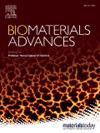Time-adaptable alterations of the extracellular matrix during chondrocyte dedifferentiation
IF 6
2区 医学
Q2 MATERIALS SCIENCE, BIOMATERIALS
Materials Science & Engineering C-Materials for Biological Applications
Pub Date : 2025-06-11
DOI:10.1016/j.bioadv.2025.214383
引用次数: 0
Abstract
Cartilage damage as a universal health problem, remains a significant cause for the development of osteoarthritis, affecting more than one million people worldwide. Poor intrinsic capacity for healing and available therapeutic strategies have severely restricted the cartilage repair post damage. Decellularized extracellular matrix (ECM) provides new thinking for the treatment of cartilage defect. However, chondrocytes dedifferentiation brings uncertainty to the researches and applications of chondrocyte-derived decellularized matrix. In this study, we demonstrated the nuclear deformation during chondrocyte dedifferentiation process, consummating the time-lapse theory atlas of chondrocyte dedifferentiation. We manufactured decellularized chondrocyte sheets (dCS) derived from different stages of dedifferentiated chondrocytes, and performed multimodal assays to characterize the mechanical, physiochemical, and proteomic properties of the dCS. Collagen II peaked at the dCS derived from plastic passage 2 chondrocytes, and decreased at the late dCS. Collagen I increased under temporal correlation. The randomness of collagen fiber direction decreased under temporal correlation, positively correlated with the ultimate tensile strength. Compared with the late dCS, the early dCS promoted cell migration, proliferation, and chondrogenic differentiation. The supplement of Fmod upregulated the biological regulatory activity of the late dCS on the chondrocyte dedifferentiation process. Overall, this study lays a foundation to improve the theory atlas of chondrocyte dedifferentiation, provides insights into cartilage repair and lay a basis for the development of new materials for cartilage repair.
软骨细胞去分化过程中细胞外基质的时间适应性改变
软骨损伤作为一个普遍的健康问题,仍然是骨关节炎发展的一个重要原因,影响着全世界一百多万人。固有的愈合能力差和现有的治疗策略严重限制了软骨损伤后的修复。脱细胞细胞外基质(ECM)为软骨缺损的治疗提供了新的思路。然而,软骨细胞脱分化给软骨细胞衍生脱细胞基质的研究和应用带来了不确定性。在本研究中,我们展示了软骨细胞去分化过程中的核变形,完善了软骨细胞去分化的延时理论图谱。我们制造了脱细胞软骨细胞片(dc),来源于不同阶段的去分化软骨细胞,并进行了多模态分析来表征dc的机械、物理化学和蛋白质组学特性。II型胶原蛋白在来源于2代软骨细胞的树突细胞中达到峰值,在树突细胞晚期下降。胶原I在时间相关性下增加。胶原纤维方向的随机性在时间相关下降低,与极限抗拉强度呈正相关。与晚期树突细胞相比,早期树突细胞促进细胞迁移、增殖和软骨分化。补充Fmod可上调晚期dc对软骨细胞去分化过程的生物调控活性。总的来说,本研究为完善软骨细胞去分化理论图谱奠定了基础,为软骨修复提供了新的见解,为软骨修复新材料的开发奠定了基础。
本文章由计算机程序翻译,如有差异,请以英文原文为准。
求助全文
约1分钟内获得全文
求助全文
来源期刊
CiteScore
17.80
自引率
0.00%
发文量
501
审稿时长
27 days
期刊介绍:
Biomaterials Advances, previously known as Materials Science and Engineering: C-Materials for Biological Applications (P-ISSN: 0928-4931, E-ISSN: 1873-0191). Includes topics at the interface of the biomedical sciences and materials engineering. These topics include:
• Bioinspired and biomimetic materials for medical applications
• Materials of biological origin for medical applications
• Materials for "active" medical applications
• Self-assembling and self-healing materials for medical applications
• "Smart" (i.e., stimulus-response) materials for medical applications
• Ceramic, metallic, polymeric, and composite materials for medical applications
• Materials for in vivo sensing
• Materials for in vivo imaging
• Materials for delivery of pharmacologic agents and vaccines
• Novel approaches for characterizing and modeling materials for medical applications
Manuscripts on biological topics without a materials science component, or manuscripts on materials science without biological applications, will not be considered for publication in Materials Science and Engineering C. New submissions are first assessed for language, scope and originality (plagiarism check) and can be desk rejected before review if they need English language improvements, are out of scope or present excessive duplication with published sources.
Biomaterials Advances sits within Elsevier''s biomaterials science portfolio alongside Biomaterials, Materials Today Bio and Biomaterials and Biosystems. As part of the broader Materials Today family, Biomaterials Advances offers authors rigorous peer review, rapid decisions, and high visibility. We look forward to receiving your submissions!

 求助内容:
求助内容: 应助结果提醒方式:
应助结果提醒方式:


